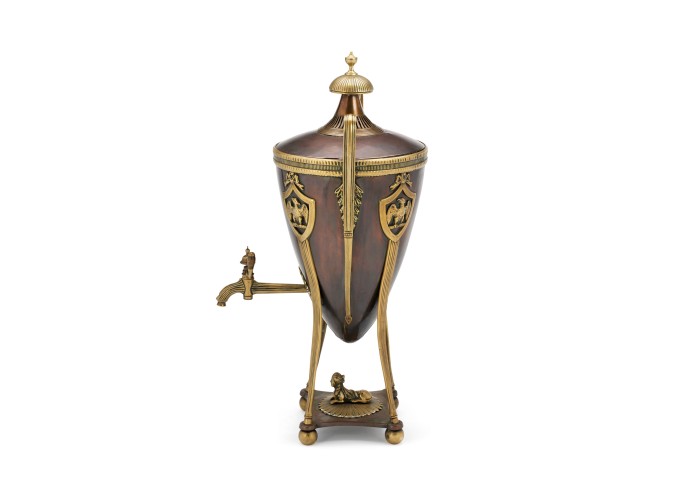Napoleon’s Samovar
This is a samovar, a Russian device used to heat water for drinks like coffee and tea. This urn was owned by the French Emperor Napoleon, and was carried in his baggage on campaign to keep his drinks warm. After the French defeat at the Battle of Waterloo, Napoleon fled and his abandoned possessions were looted by victorious British, Dutch, and German soldiers.
Tea had been drunk in China since the third century BC, but only in Russia since the 1600s. The drinking of tea evolved into a social ceremony, centred on the samovar (in Russian, this means a ‘self-boiler’). These boilers were also used in the Middle East and Kashmir. There are two samovars which were once in the possession of the Emperor Napoleon, both of which passed from the United Services Museum onto the National Army Museum.
A samovar, from a design based on the Tibetan hotpot, is an elaborate tea-making device, consisting of a metallic urn (usually made of copper, brass or silver), supported on legs, with insulated handles, a steam vent and, usually, a tap. Hot coals, charcoal or wood are placed in a heating chamber, which has a chimney that emits the hot air. This circulates in a pipe placed in a water container, so heating the water. The boiling water rises to a separate chamber, in which the tea is brewed. Strong dark brews (named Zavarka), were sweetened with honey or sugar. Occasionally coffee was brewed in samovars.
In Napoleon’s many campaigns, he often adopted the habits or clothing of the country in which he operated. In the disastrous Russian campaign of 1812, he wore Russian hats and furs and travelled in horse drawn sleighs. He no doubt had the samovars to provide him with warming drinks. This samovar was possibly made in France in 1815 (maker unknown) and two were captured by British troops after Bonaparte had abandoned his carriage, to ride away from the battlefield of Waterloo on horseback.
-
Curatorial info
- Originating Museum: National Army Museum
- Accession Number: NAM. 1963-10-245
-
Use this image
You can download and use the high resolution image under a Creative Commons licence, for all non-commercial purposes, provided you attribute the copyright holder.
- Rights Holder: Copyright National Army Museum. Photography Relic Imaging Ltd.
- License Type: Creative Commons
Find it here
This object is in the collection of National Army Museum












